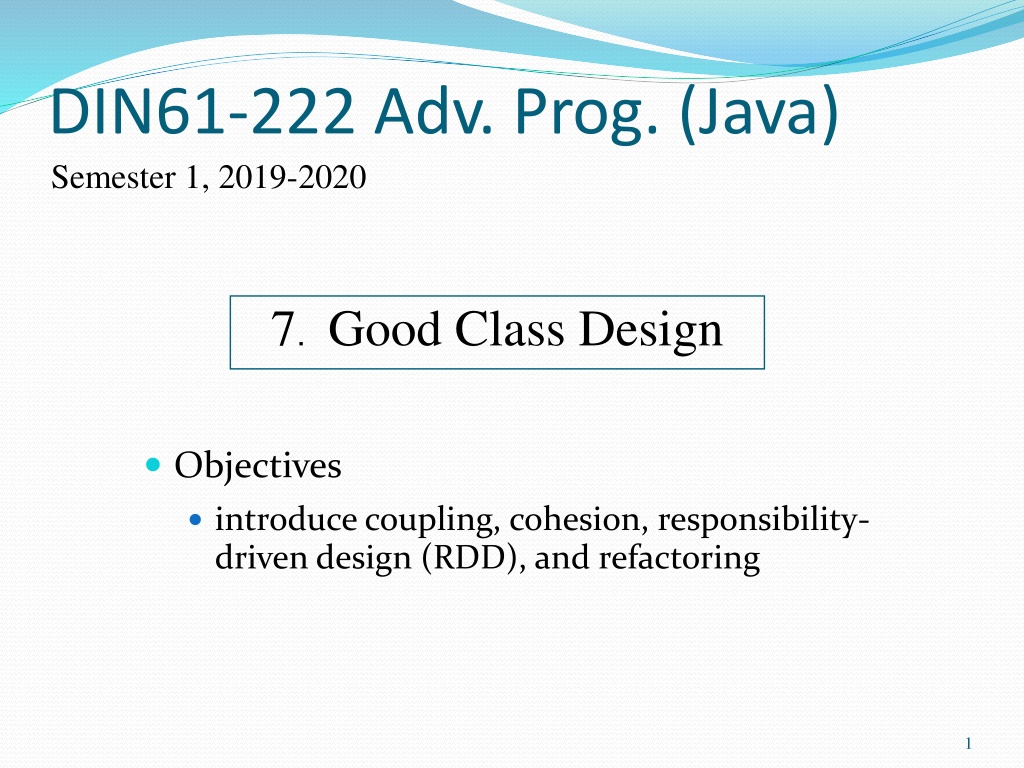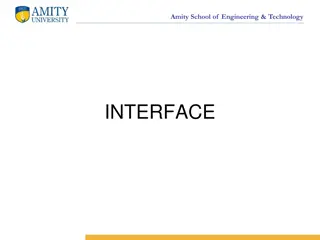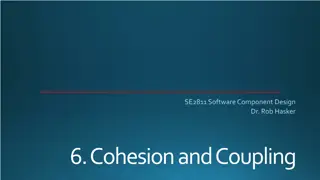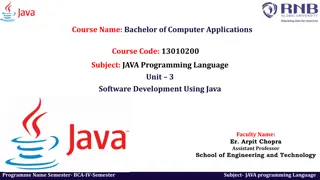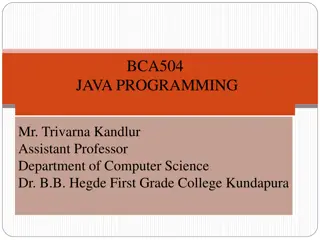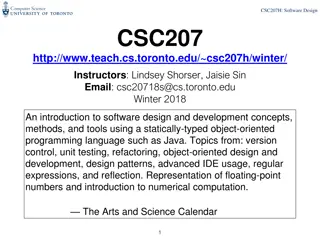Exploring Class Design in Java Programming: Coupling, Cohesion, RDD, and Refactoring
Delve into the world of Java programming with a focus on class design principles such as coupling, cohesion, responsibility-driven design (RDD), and refactoring. Understand the importance of good design for code quality, ease of debugging, maintenance, and reusability. Dive into the adventure of Zuul game development and class descriptions to grasp essential concepts for creating efficient Java applications.
Download Presentation

Please find below an Image/Link to download the presentation.
The content on the website is provided AS IS for your information and personal use only. It may not be sold, licensed, or shared on other websites without obtaining consent from the author. Download presentation by click this link. If you encounter any issues during the download, it is possible that the publisher has removed the file from their server.
E N D
Presentation Transcript
DIN61-222 Adv. Prog. (Java) Semester 1, 2019-2020 7. Good Class Design Objectives introduce coupling, cohesion, responsibility- driven design (RDD), and refactoring 1
1. Why Class Design? Getting code to work isn't enough. The code must also be beautiful. Benefits of good design: simplifies debugging, modification, maintenance makes the code easier to reuse in other projects 2
My input follows the ">>" zuul prompts. 2. World of Zuul 3
Zuul Features The user can move between a series of rooms, get help, and quit A real adventure game would allow multiple users, include hidden treasure, secret passwords, death traps, and more. 4
Zuul Map rooms pub outside theatre exits/ doors lab office The user starts in the "outside" room. The exits are to the North, South, East, and West 5
Zuul Class Diagrams I can see some problems already! 6
Class Descriptions ZuulGame creates the rooms, the parser, and starts the game. It evaluates and executes the commands that the parser returns. Parser repeatedly reads a line from the terminal and interprets it as a two word command which it returns as a Command object continued 7
CommandWords holds an array of all the command words in the game, which is used to recognise commands "go", "quit", "help" Room represents a room in the game, connected to other rooms via exits. The exits are labelled "north", "east", "south", and "west". continued 8
Command holds information about a user command, consisting of at most two strings e.g. "go" and "south" 9
3. Code Design Concepts Coupling Cohesion Responsibility-driven Design (RDD) Refactoring Code Size Thinking Ahead 10
3.1. Coupling Coupling are the links between classes in an application. If two classes depend on many details of each other, they are tightly coupled. Usually bad. Good design aims for loose coupling. Good. 11
Loose Coupling In class diagrams, loose coupling means less lines Loose coupling makes it possible to: understand one class without reading others change one class without affecting others Loose coupling make debugging, maintenance, and modification easier. 12
Implicit Coupling Tight coupling based on publicdata fields is easy to find look at the class diagram (see slide 6) Implicit coupling are links that are hard to see. 13
3.2. Cohesion Cohesion is the mapping of tasks to methods and classes. High Cohesion is good. It means: each class should represent one thing each method should do one operation Example: the Plane class represent a plane Plane.land() does one task continued 14
High cohesion makes it easier to: understand a class or method give good names to the class or method reuse classes or methods in other applications 15
3.3. Responsibility-driven Design (RDD) Each class must protect its data e.g. only use privatefields RDD usually means that code changes will be localized, which is good i.e. a change only affects the class/method that is being modified this makes the change easier to understand and implement corectly 16
3.4. Refactoring Refactoring is a two-stage redesigning of classes/methods when an application needs modifying. Usually this leads to existing classes/methods being split up, and new classes/methods are added. continued 17
Two Steps 1. Restructure the existing code, keeping the same functionality, with very simple new classes/methods. debug and test them 2. Add new functionality to the new classes/methods created in step 1. debug and test again 18
3.5. Code Size Common questions: how big should a class be? how big should a method be? A method is probably too long if it does more then one task (e.g. Plane.land_and_take_off()) A class is probably too complex if it represents more than one thing (e.g. Luggage_and_Passenger class) 19
3.6. Thinking Ahead When designing a class, think what changes are likely in the future aim to make those changes easier Example: if the user interface is going to change (e.g. text-based GUI) then make sure all the I/O is carried out in one class 20
4. Code Duplication in Zuul Code duplication (BAD) means that a single design change requires code changes in many places makes maintenance harder this is a form of tight coupling e.g. printWelcome() and goDirection() in Room continued 21
private void printWelcome() { System.out.println(); System.out.println("Welcome to the World of Zuul!"); System.out.println("Type 'help' if you need help."); System.out.println(); System.out.println("You are " + currRoom.description); System.out.print("Exits: "); if (currRoom.northExit != null) System.out.print("north "); if (currRoom.eastExit != null) System.out.print("east "); if (currRoom.southExit != null) System.out.print("south "); if (currRoom.westExit != null) System.out.print("west "); System.out.println(); } // end of printWelcome() continued 22
private void goDirection(Command command) { : System.out.println("You are " + currRoom.getInfo()); System.out.print("Exits: "); if (currRoom.northExit != null) System.out.print("north "); if (currRoom.eastExit != null) System.out.print("east "); if (currRoom.southExit != null) System.out.print("south "); if (currRoom.westExit != null) System.out.print("west "); System.out.println(); } } // end of goDirection() looks familiar 23
5. Poor RDD in Zuul The Room class has poor RDD (BAD): it uses public fields public String description; public Room northExit, southExit, eastExit, westExit; The Room implementation is exposed. Instead, use privatefields and get methods e.g. getExit() continued 24
Only Room should manage the room desciption, but since it's a publicfield, ZuulGame can use it directly: in ZuulGame.printWelcome(): System.out.println("You are " + currRoom.description); Make the description field private, and add a get method (getInfo()). 25
6. Ease of Modification of Zuul? If adding a new, simple task to the design means a lot of extra coding, then it's an indication that the original design is probably bad. e.g. how easy is it to add "up" and "down" to the "go" command? continued 26
This requires changes in: Room setExits() createRooms() printWelcome() goDirection() ZuulGame room exits are manipulated in too many places: BAD 27
Why Limit the Exits? The Room design limits the exits to be "north", "south", "east" and "west". Why? Probably BAD. The Room class should allow any number of exits, in any direction: use a HashMap to map a direction name (e.g. "up") to an adjacent Room object continued 28
private HashMap<String, Room> adjRooms; // maps directions to adjacent rooms // in the Room constructor adjRooms = new HashMap<String, Room>(); // no adjacent rooms initially public void setAdjacentRoom(String dir, Room neighbour) { adjRooms.put(dir, neighbour); } continued 29
The limit of four directions in Room is visible outside the class because of Room.setExits() used by ZuulGame: Room outside = new Room("outside the main entrance"); Room theatre = new Room("in a lecture theatre"); Room pub = new Room("in the campus pub"); Room lab = new Room("in a computing lab"); Room office = new Room("in the admin office"); // link the room exits outside.setExits(null, theatre, lab, pub); theatre.setExits(null, null, null, outside); pub.setExits(null, outside, null, null); lab.setExits(outside, office, null, null); office.setExits(null, null, null, lab); 4 arguments means 4 exits continued 30
Recode the interface change setExits() to setAdjacentRoom(), which sets one exit, and then call it as many times as needed Room outside = new Room("outside the main entrance"); Room theatre = new Room("in a lecture theatre"); Room pub = new Room("in the campus pub"); Room lab = new Room("in a computing lab"); Room office = new Room("in the admin office"); // link adjacent rooms outside.setAdjacentRoom("east", theatre); outside.setAdjacentRoom("south", lab); outside.setAdjacentRoom("west", pub); theatre.setAdjacentRoom("west", outside); pub.setAdjacentRoom("east", outside); lab.setAdjacentRoom("north", outside); : multiple calls means multiple exits 31
7. Implicit Coupling in Zuul The current commands: go, help, quit Add "look" to examine a room without going into it. Requires changes to: CommandWords ZuulGame: modify processCommand() and add a look() method continued 32
in processCommand(): String cmdWord = cmd.getFirstWord(); if (cmdWord.equals("help")) printHelp(); else if (cmdWord.equals("go")) goDirection(cmd); else if (cmdWord.equals("quit")) isFinished = tryQuit(cmd); else if (cmdWord.equals("look")) look(); // else ignore any other words continued 33
What about the output of "help": The "help" command is implicitly coupled to CommandWords, which means that "help" should use it to list the commands. continued 34
Current version of printHelp(): private void printHelp() { System.out.println("Please wander around at the university."); System.out.println(); System.out.println("Your command words are:"); System.out.println(" go quit help"); } implicit coupling to CommandWords 35
8. Code Size in Zuul How should items be added to the rooms? an item has a description and weight Bad approach: add description and weight fields to Room Good approach: create an Item class, and add a "collection of Items" field to Room 36
9. Refactoring in Zuul How can multiple players be added to the game? currently there is one player represented by the current room he/she is occupying private Room currRoom; // in ZuulGame Based on RDD, players should be represented by objects of a new Player class. 37
Refactoring: Steps 1 and 2 1. Move currRoomto a new Player class. Test ZuulGame with one Player object. 2. Add the extra player fields to Player (e.g. items, strength). Test ZuulGame with one, two, several Player objects. 38
10. Self-study Part 16 of these slides (16. Coding Style) gives some simple hints about good coding style, which you should use when coding the project. I will not go through Part 16 in class; you should read it yourself. 39
